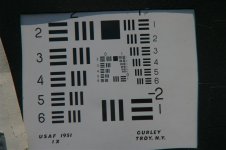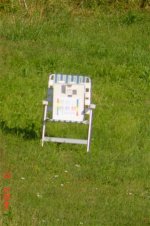Guys,
I hate to be a blabbemouth, but this little paragraph is imbedded (post #41) in the current thread on the Zeiss 8x42 FL that has turned into discussions of global economy and stuff. I was afraid you'd miss it, and would appreciate any feedback criticism and advice.
I saith:
"Yesterday, I did a centerfield resolution test comparing it to my Trinovid BA, booted to 64x. Weather limited my setup space, so the period of my finest target was a rather fat 3.4 arcsec. The target was alternating black and white stripes, running in four directions. Both barrels of both binoculars could discern which way all the lines ran, but there were differences in the quality of the view. The left barrel was better in both binoculars, and handled the target easily, but the Leica was a tad better. The right barrel of the Zeiss was a little bit worse on three directions, but still handled those three directions easily, but the fourth direction was worse, and I could tell which way the lines ran, but barely, so, some astigmatism there. The right barrel of the Leica was also worse than the left, but not much, and without astigmatism. Overall, the Leica was the close winner. By only barely getting the worst direction in the right barrel, I believe that barrel of the Zeiss could be said to be "resolve" 3.4 arcsec, and all the other barrels were better. Although not well quantified, I believe this is about medium resolution quality for an alpha binocular, the Leica a bit better than average, comments please optics buffs."
Thank you,
Ron
I hate to be a blabbemouth, but this little paragraph is imbedded (post #41) in the current thread on the Zeiss 8x42 FL that has turned into discussions of global economy and stuff. I was afraid you'd miss it, and would appreciate any feedback criticism and advice.
I saith:
"Yesterday, I did a centerfield resolution test comparing it to my Trinovid BA, booted to 64x. Weather limited my setup space, so the period of my finest target was a rather fat 3.4 arcsec. The target was alternating black and white stripes, running in four directions. Both barrels of both binoculars could discern which way all the lines ran, but there were differences in the quality of the view. The left barrel was better in both binoculars, and handled the target easily, but the Leica was a tad better. The right barrel of the Zeiss was a little bit worse on three directions, but still handled those three directions easily, but the fourth direction was worse, and I could tell which way the lines ran, but barely, so, some astigmatism there. The right barrel of the Leica was also worse than the left, but not much, and without astigmatism. Overall, the Leica was the close winner. By only barely getting the worst direction in the right barrel, I believe that barrel of the Zeiss could be said to be "resolve" 3.4 arcsec, and all the other barrels were better. Although not well quantified, I believe this is about medium resolution quality for an alpha binocular, the Leica a bit better than average, comments please optics buffs."
Thank you,
Ron





